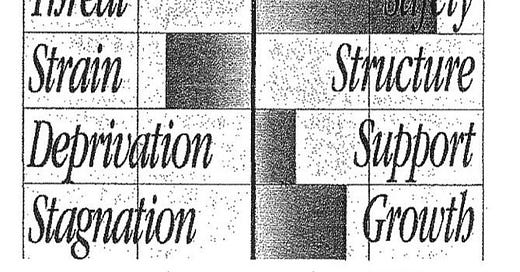We humans are very reactive and responsive to environmental conditions. That’s a good thing, because we would not survive if we weren’t. Adapting to the opportunities and threats in our immediate surroundings so we can survive and thrive is our mission in life.
The field of psychology had a big debate back in the later 20th century over whether humans behavior was driven mostly by internal forces (as in psychoanalytic theory) or by external conditions (as in “behaviorism”). Of course the truth, as with most simplistic either/or debates (like genes vs. experience), is both/and. Our behavior is usually a complex interaction between who we are and the situation we are in, though the relative contribution of each will be different depending on person and context.
The problem of “burnout”
In my consulting on the problem of workplace burnout, I have discovered that Sigmund Freud is still alive and well in the executive suite and Human Resources department. Burnout is generally viewed as a set of symptoms INSIDE of people, and so various “treatments” (stress management/mindfulness training, anti-depressants, performance reviews) are prescribed. This “medical” paradigm is applied even though all the research shows that burnout is a condition produced by very specific ENVIRONMENTAL conditions. There are reasons for this willful ignorance.
I am a fan of the “First assess, then intervene” model of care. Assessment involves gathering relevant information about the condition you’re concerned about so you can apply the most efficacious intervention. Most research on workplace burnout uses the Maslach Burnout Inventory to measure the symptoms (fatigue, disengagement, demoralization, etc.) IN people, which reinforces the use of person-focused interventions. Since assessment should focus on the things that really matter, I developed a survey (Workscan) that measures the environmental factors that determine how much energy and engagement people have on the job.
A healthy workplace
People will perform better, commit more fully to their work, and be healthier (both emotionally and physically) if they work in a “healthy” workplace. But what does that mean exactly? What does a healthy workplace look like? How can you measure it, let alone build it?
Look at this picture ⬇️
Extensive occupational health research reveals the key features of a healthy work environment as
SAFETY (vs. Threat)
STRUCTURE (vs. Strain)
SUPPORT (vs. Deprivation)
GROWTH (vs. Stagnation)
SAFETY = the absence of physical danger and emotional threat, and the presence of an adequate salary
STRUCTURE = a combination of role clarity, manageable workload and decision-making authority/control over one’s work
SUPPORT = cooperative work relationships, a boss who understands and cares about their employees’ concerns, and adequate resources to do the job
GROWTH = opportunities for learning and more interesting work over time (and ideally some mentoring)
Work Strain produces high rates of burnout, talent loss and negative performance evaluations. High levels of Support, Structure and Growth can buffer some of these ill effects (as in the best professional training programs, sports teams and military units).
Organizations that invest in building a safe, structured, supportive and growth-promoting work environment can derive a return-on-investment in the range of 500–800% ($5–8 profit per dollar invested) due to improved performance and reduced talent related costs. But few leaders make that humane and profitable investment for all the obvious reasons. Sad.
Q: Do you have a “healthy” job? What would your Workscan X-ray look like?
References
Karasek & Theorell, Healthy Work: Stress, Productivity and the Reconstruction of Working Life
Brightman, Building Professional Satisfaction and Effectiveness: A Case Study, Health Forum Journal
Brightman, Stress Culture, HUMAN NATURE
Gallup Inc., Employee surveys and performance/engagement research
Phillips, Stone & Phillips, The Human Resources Scorecard: Measuring the Return on Investment




Happy Friday Baird,
I love how you broke down what makes a healthy workplace. It's not rocket science - safety, structure, support, growth. Sounds like the basics of any good relationship, right? But how many of us can actually say our jobs tick all those boxes? Not me lol
That bit about the return on investment for creating better workplaces is mind-blowing. 500-800% profit for every dollar spent? You'd think companies would be all over that. But nope, we're still stuck in this old-school mindset of grinding people down. I don't know if this will ever change.
Thank you for sharing.
I hope you have an amazing weekend!
I'm long retired, but in my former life, burnout was never a problem for me or my co workers. Perhaps that was because our work environment met all your optimal requirements. I wonder if the top people were reading you, Baird! Great essay.